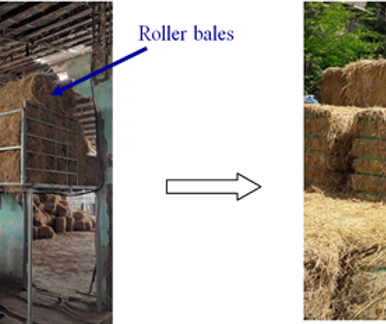 PHÁT TRIỂN SẢN PHẨM NÉN TỪ RƠM NHẰM GIẢM CHI PHÍ VẬN CHUYỂN VỚI MỤC ĐÍCH SỬ DỤNG LÀM THỨC ĂN TRONG CHĂN NUÔI
PHÁT TRIỂN SẢN PHẨM NÉN TỪ RƠM NHẰM GIẢM CHI PHÍ VẬN CHUYỂN VỚI MỤC ĐÍCH SỬ DỤNG LÀM THỨC ĂN TRONG CHĂN NUÔIPHÁT TRIỂN SẢN PHẨM NÉN TỪ RƠM NHẰM GIẢM CHI PHÍ VẬN CHUYỂN VỚI MỤC ĐÍCH SỬ DỤNG LÀM THỨC ĂN TRONG CHĂN NUÔI. (DEVELOPING DENSIFIED PRODUCTS TO REDUCE TRANSPORTATION COSTS AND IMPROVE THE QUALITY OF RICE STRAW FEEDSTOCKS FOR CATTLE FEEDING) Nguyen Van Hieu1*; Nguyen Thanh Nghi2; Le Quang Vinh3 Le Minh Anh4; Nguyen Van Hung5; Martin Gummert6 1Tien Giang University, 119 Ap Bac, Ward 5, My Tho City, Tien Giang Province, Vietnam; 2,3Nong Lam University, Thu Duc District, Ho Chi Minh City, Vietnam; 4Binh Minh Group, 784 National Road 50, Cho Gao.
PHÁT TRIỂN SẢN PHẨM NÉN TỪ RƠM NHẰM GIẢM CHI PHÍ VẬN CHUYỂN VỚI MỤC ĐÍCH SỬ DỤNG LÀM THỨC ĂN TRONG CHĂN NUÔI

----------------------------------------------------------------------------------------------------------------------------------------
Nguyen Van Hieu1*; Nguyen Thanh Nghi2; Le Quang Vinh3
Le Minh Anh4; Nguyen Van Hung5; Martin Gummert6
1Tien Giang University, 119 Ap Bac, Ward 5, My Tho City, Tien Giang Province, Vietnam;
2,3Nong Lam University, Thu Duc District, Ho Chi Minh City, Vietnam;
4Binh Minh Group, 784 National Road 50, Cho Gao District, Tien Giang Province;
5,6International Rice Research Institute, DAPO Box 7777, Metro Manila, Philippines
--------------------------------------------------------------------------------------------------------------
Journal of Vietnamese Environment, Vol 10, No 1 (2018), pp: 11-15, Technical University Dresden, Germany.
-----------------------------------------------------------------------------------------------------------------
Tóm tắt: Nén ép rơm là quá trình quan trọng và cần thiết để tăng khối lượng thể tích với mục đích giảm chi phí vận chuyển. Trong nghiên cứu này, chúng tôi đã thực hiện nghiên cứu đánh giá tính khả thi về kỹ thuật và kinh tế đối với nội dung nén ép rơm cuộn và ép viên rơm. Cùng với mục đích chính là tăng dung trọng của sản phẩm từ rơm, chúng tôi cũng đánh giá chất lượng sản phẩm làm thức ăn cho bò giúp cho tăng kích thích quá trình tiêu hóa. Kết quả nén ép cuộn rơm đã làm tăng dung trọng của kiện rơm đến 400% (từ 94 đến 398.7 kg.m-3). Qua đó, đã giảm được chi phí vận chuyển 60% được ước tính cho 60 km khoảng cách vận chuyển. Đối với ép viên rơm, dung trọng tăng đến 700% (từ 94 đến 666 kg.m-3). Hàm lượng dinh dưỡng của viên nén hỗn hợp rơm gồm protein (12,1%), chất béo (2,8%), chất xơ (32,7%), và lượng tro tổng (11,2%). Ngoài ra, kết quả thử nghiệm cho bò ăn sản phẩm viên nén này cho thấy bò có cảm giác thích và ăn hết toàn bộ viên nén. Kết quả của nghiên cứu đã góp phần giảm chi phí khi sản xuất thức ăn cho bò, tăng thu nhập cho người nông dân và từ đó giảm tác động môi trường do việc đốt rơm trên đồng.
Abstract: Densification of rice straw such as compacting and pelletizing is an important process to increase the density of rice straw resulting in a reduction of transportation cost. Within this research, we conducted a techno-economic investigation of rice straw densification to produce compressed bales and pellets, which are later used for animal feed. In line with the main deliverable of the performance of rice straw compacting and pelletizing processes, we also looked into the quality of the product in terms of uptake and digestibility of the cattle feed which could be improved by adding amendments such as urea during the compacting process. The compacting technology resulted in a 400% increase of bale density (from 94 to 390 kg.m-3). This could reduce transportation costs by about 60% for a 60 km driving distance using trucks. The net profit that resulted from compacted bales was USD 0.0062 kg-1. Although the pelletizing technology increased the cost of the densified product by 40–50%, its density increases by 700%, from 94 to 666 kg.m-3. The enriched-rice straw pellets contained 12.1% protein, 2.8% lipid, 32.7% raw fibre, and 11.2% ash. In addition, a test of this product for cattle feeding illustrated an increase in its eating desirability for cows. Findings from this study contribute to reducing feedstock cost and developing densified rice straw products. These, therefore, provide more alternative options to increase the benefits from rice production and thus, reduce the unsustainable burning of rice straw in the field.
Keywords: Rice straw, densification, pellet, cattle feed, greenhouse gas emission
Số lần xem trang: 3796

